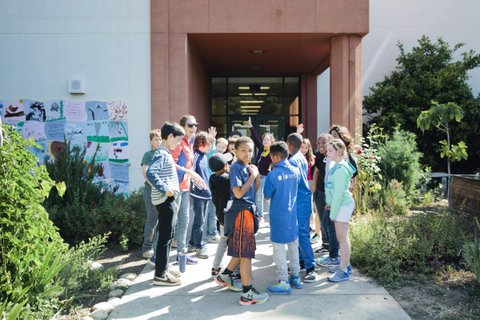
10 Jan WCCUSD Proposes More Cuts, Says Higher Attendance Could Prevent Them

(Screenshot captured by Samantha Kennedy / The CC Pulse)
By Samantha Kennedy
The West Contra Costa Unified School District’s $7.2 million in proposed cuts for the next school year are $12 million less than those implemented this school year, but the numbers — in dollars, jobs and people — are still too high for some.
For the 2025-26 school year, WCCUSD proposes cuts to 43 full-time positions and $3.9 million to its central office’s services to keep the district in control of local finances.
The cuts, which are year two of a fiscal solvency plan lasting from 2024 to 2026, most affect teachers in secondary schools, the College & Career program, and paraprofessionals.
In addition to next year’s proposed cuts, another $6 million has to be cut in the 2026-27 school year, totaling $13 million over the next two school years. That’s also an additional 47 cuts to full-time employee positions in the 2026-27 year.
“Please remember that these recommendations are not made lightly,” Interim Superintendent Kim Moses read off a prepared statement following a presentation of the proposal at Wednesday’s school board meeting, “and are driven by the need to align our expenditures with our revenues and address the district’s structural deficit.”
Moses, who recently took over for Kenneth “Chris” Hurst following his abrupt retirement, reassured community members that the proposed cuts are not a complete elimination of programs but only reductions.
That proposal came after nearly two hours of public comment at Wednesday’s meeting, where most speakers online and in person shared concerns about the potential loss of impactful staff and programs that are already happening because of current reassignments.
“You know this isn’t the solution to the teacher shortage,” said Rich Seeber, an instructional coach. “The list of reassignments have already been reduced to such an extent that it will have almost no impact on teacher staffing but will have a detrimental impact on teacher support, school functioning and student learning.”
>>>Read: Teacher and Her Students Agree: Layoffs Not the Answer to WCCUSD Budget Woes<<<
Budget woes have been one of WCCUSD’s most pressing issues over the past several years. Compounded by declining enrollment and Average Daily Attendance — which determines funding and, since the 2020-21 school year, has declined by nearly 4,000 — expiration of one-time COVID funds and rising costs for special education programs, the district had to implement a multi-year fiscal solvency plan that identified $32.7 million in cuts.
But, Moses said, budget reductions don’t fully address the district’s long-term fiscal stability. Increasing the ADA by almost 3%, for example, could remove the need for the reductions.
The 3% increase in the ADA would result in an approximately $7.7 million increase in revenue, according to Moses. That increase, however, does not mean an increase in enrollment, which is separate from the ADA and typically higher.
According to the California Department of Education, ADA is usually lower than enrollment because of dropouts, illness and transience.
Addressing chronic absenteeism is already something the district is doing in hopes of increasing attendance.
>>>Read: WCCUSD Tries to Figure Out How It ‘Can Improve Those Numbers’<<<
Summer Sigler, associate superintendent of school operations, said there’s been a 13% decrease as the result of a chronic absenteeism reduction campaign.
“The bad news is that strategy is no longer pushing up overall attendance because the number of students that are chronically truant has reduced,” she said. “So, we need to switch strategies. We will still address chronic absenteeism, but we need now to broaden the outreach and look at students who are missing a few days of school that don’t meet that chronically absenteeism level.”
WCCUSD is not the only California district struggling with chronic absenteeism since the pandemic, with the number of chronically absent students nearly doubling from 2019 to 2023, according to the California Department of Education.
Chronic absenteeism also disproportionately impacts underserved student populations like students with disabilities and English learners, according to data from the U.S. Department of Education.
“I just hope when you’re doing the budget and look at equity, ensuring that the data is good for all students (who) require different resources,” said Zelon Harrison, who sits on the Community Advisory Committee for Special Education and the African American Site Advisory Team. “The resources that different students need, I hope you’re taking that into consideration.”
Moses welcomed input from community members and the board on increasing revenue, but still pointed to attendance being the answer.
“Plain and simple: We get revenue based upon the number of students,” said Moses, “so the only answer to how we can generate more, in terms of addressing this issue, is by increasing” the ADA.
And additional cuts “will likely be necessary to achieve a balanced budget in future years,” according to Moses’ reduction report.
“WCCUSD will continue to explore other options to enhance fiscal stability including a campaign to increase Annual Daily Attendance rates and a plan to identify ongoing fiscal reductions on non-classroom expenditures,” the report reads.
The next West Contra Costa school board meeting is Jan. 29.






Sky Nelson
Posted at 21:53h, 09 FebruaryThere is an important difference between “enrollment” and “attendance”. Enrollment problems are largely out of the districts control, based on demographics. Attendance is much more solvable, since it involves behavior not demographics.. If we do better understanding students needs and motivations and serving their interests, we will increase attendance. Your article is misleading because it uses these words interchangeably. Please correct it, thank you. (from a teacher)
Danielle Parenteau-Decker
Posted at 13:25h, 19 FebruaryHello. Thanks for your feedback. These are good points that you raise. You are right about the difference. We used the terms interchangeably because interim Superintendent Kim Moses did so at the meeting, but we see the confusion it could cause and have updated the story to make it clearer and more precise. Thank you for reading!